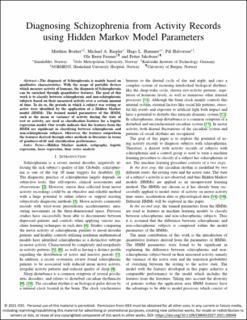| dc.contributor.author | Boeker, Matthias | |
| dc.contributor.author | Riegler, Michael | |
| dc.contributor.author | Hammer, Hugo Lewi | |
| dc.contributor.author | Halvorsen, Pål | |
| dc.contributor.author | Fasmer, Ole Bernt | |
| dc.contributor.author | Jakobsen, Petter | |
| dc.date.accessioned | 2022-11-25T13:35:31Z | |
| dc.date.available | 2022-11-25T13:35:31Z | |
| dc.date.created | 2021-12-20T09:15:07Z | |
| dc.date.issued | 2021-07-12 | |
| dc.identifier.isbn | 978-1-6654-4121-6 | |
| dc.identifier.isbn | 978-1-6654-3107-1 | |
| dc.identifier.issn | 2372-9198 | |
| dc.identifier.issn | 2372-918X | |
| dc.identifier.uri | https://hdl.handle.net/11250/3034144 | |
| dc.description.abstract | The diagnosis of Schizophrenia is mainly based on qualitative characteristics. With the usage of portable devices which measure activity of humans, the diagnosis of Schizophrenia can be enriched through quantitative features. The goal of this work is to classify between schizophrenic and non-schizophrenic subjects based on their measured activity over a certain amount of time. To do so, the periods in which a subject was resting or active were identified by the application of a Hidden Markov model (HMM). The trained model parameters of the HMM, such as the mean or variance of activity during the state of rest or activity, are used as classification features for a logistic regression model. Our results indicate that the features from the HMM are significant in classifying between schizophrenic and non-schizophrenic subjects. Moreover, the features outperform the features derived through other methods in literature in terms of goodness-of-fit and classification performance. | en_US |
| dc.language.iso | eng | en_US |
| dc.publisher | Institute of Electrical and Electronics Engineers | en_US |
| dc.relation.ispartof | Proceeding of 2021 IEEE 34th International Symposium on Computer-Based Medical Systems (CBMS) | |
| dc.relation.ispartofseries | Annual IEEE Symposium on Computer-Based Medical Systems;2021 IEEE 34th International Symposium on Computer-Based Medical Systems | |
| dc.subject | Hidden Markov models | en_US |
| dc.subject | Actigraphy | en_US |
| dc.subject | Logistic regression | en_US |
| dc.subject | Lasso regression | en_US |
| dc.subject | Time series analyses | en_US |
| dc.title | Diagnosing Schizophrenia from Activity Records using Hidden Markov Model Parameters | en_US |
| dc.type | Conference object | en_US |
| dc.description.version | acceptedVersion | en_US |
| cristin.ispublished | true | |
| cristin.fulltext | original | |
| cristin.fulltext | postprint | |
| cristin.qualitycode | 1 | |
| dc.identifier.doi | https://doi.org/10.1109/CBMS52027.2021.00048 | |
| dc.identifier.cristin | 1970354 | |
| dc.source.volume | 34 | en_US |
| dc.source.issue | 34 | en_US |
| dc.source.pagenumber | 6 | en_US |
